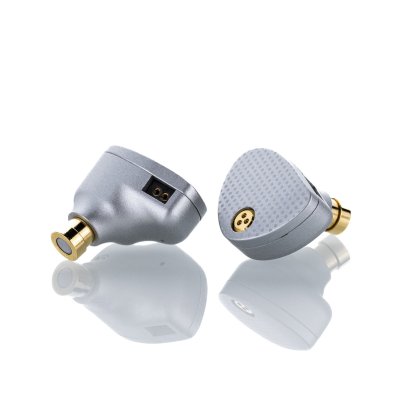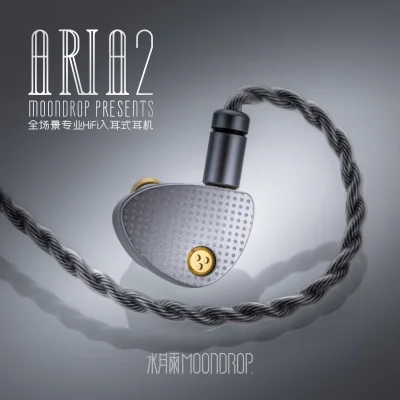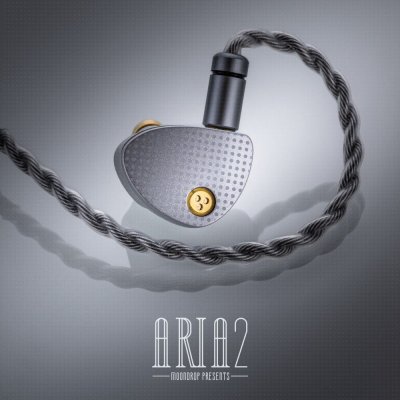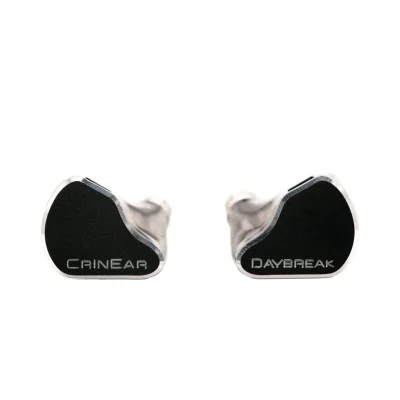Moondrop Aria 2 and Crinear Daybreak are in-ear monitors. Moondrop Aria 2 costs $79 while Crinear Daybreak costs $170. Crinear Daybreak is $91 more expensive. Crinear Daybreak holds a decisive 1.1-point edge in reviewer scores (6.2 vs 7.3). Crinear Daybreak carries a user score of 7.4. Crinear Daybreak has significantly better bass with a 1.1-point edge, Crinear Daybreak has better mids with a 0.9-point edge, Crinear Daybreak has slightly better treble with a 0.3-point edge, Crinear Daybreak has significantly better dynamics with a 2.4-point edge, Crinear Daybreak has better soundstage with a 0.5-point edge, Crinear Daybreak has significantly better details with a 1.2-point edge and Crinear Daybreak has significantly better imaging with a 2.2-point edge.
Insights
| Metric | Moondrop Aria 2 | Crinear Daybreak |
|---|---|---|
| Bass | 6.5 | 7.6 |
| Mids | 6.5 | 7.4 |
| Treble | 6.3 | 6.6 |
| Details | 6.5 | 7.7 |
| Soundstage | 6.5 | 7 |
| Imaging | 5.5 | 7.7 |
| Dynamics | 5 | 7.4 |
| Tonality | 6.1 | 7.5 |
| Technicalities | 6.3 | 6.9 |
Moondrop Aria 2 Aggregated Review Score
Average Reviewer Scores
Average Reviewer Score:
6.2Mixed to Positive
Crinear Daybreak Aggregated Review Score
Average Reviewer Scores
Average Reviewer Score:
7.3Generally Favorable
Reviews Comparison
Moondrop Aria 2 reviewed by Z-Reviews
Youtube Video Summary
Moondrop switches up the formula with Aria 2’s single dynamic “dome” driver, creating a presentation that feels set back from the head with surprising soundstage depth and precise positional cues. Instead of shoving detail forward, the tuning stays smooth, coherent, and non-fatiguing while still keeping vocals engaging and treble tidy. At $89, it becomes the new default pick in the sub-$100 bracket—easily preferred over other budget crowd-pleasers—thanks to that airy layering and “in-the-room” spacing that’s rare at this price.
Build and accessories are enthusiast-friendly: a weighty metal shell, recessed 2-pin, and a modular cable with 3.5/4.4 mm ends (the 4.4 plug fits tight, but locks solidly). The nozzle uses a replaceable acoustic filter and there’s a pressure-relief vent, though no spare filters are included and the tip selection is basic. Pairing scales well—from clean Class-A amps to punchy portables—without upsetting the balance; different sources simply shift flavor, not quality. Add the unexpectedly classy design and this becomes an easy top recommendation under $100 for listeners who value staging, ease, and refinement over brute-force brightness.
Z-Reviews Youtube Channel
Buy Moondrop Aria 2 on Linsoul
Ad
Price: $99.99
Buy Moondrop Aria 2 on Linsoul
Crinear Daybreak reviewed by Z-Reviews
Youtube Video Summary
The Crinacle Daybreak is a technically excellent IEM that offers exceptional clarity and detail retrieval without being fatiguing. Its five-driver configuration delivers a cohesive and precise sound signature that is clean, flat, and incredibly balanced. The bass is present and punchy but never exaggerated, making it a perfect tool for studying music and hearing every nuance in a recording.
However, this precision comes at the cost of fun. The tuning is described as a little dry and somewhat intimate, lacking the expansive soundstage and flavorful character that makes other IEMs more engaging for pure enjoyment. While the build is solid with an acceptable cable and nice connectors, its looks are admittedly boring. It’s a perfectly cooked meal that follows the recipe without any surprises.
Ultimately, the Daybreak is a highly respected and much-loved IEM that fills a specific niche for a clean, reference-like sound. It’s a business suit of an IEM, but it wouldn't be the first choice for someone looking for a more exciting, fun, or "f***ed up" sound signature to get them moving. It commands respect for its technical merits, even if it isn't to everyone's personal taste.
Z-Reviews Youtube Channel
Buy Crinear Daybreak on Linsoul
Ad
Price: $169.99
Buy Crinear Daybreak on Linsoul
Moondrop Aria 2 reviewed by Jaytiss
Youtube Video Summary
Build and accessories hit above the price: a metal shell with a golden nozzle, medium-sized fit, solid lip for tips, and a tasteful faceplate flourish. The stock cable feels premium with clear L/R markings, a chin slider, and an easy quick-swap plug system that makes 3.5↔4.4 painless. The case is a standout—leatherette feel, smooth zipper—and the tips selection is practical. Street price hovers around $90, often dipping to the $60–70 range during sales, which makes the overall package compelling for the money.
Sonically, Aria 2 leans on clean upper-mids and a smooth treble with a lighter bass shelf; dynamics are modest, imaging is respectable, and resolution is good for the tier. It tracks very close to the original Aria’s tonality (with slightly less bass) and overlaps with Moondrop’s current lineup enough to reduce the appeal of some pricier siblings, while outclassing bright-tilted alternatives like Dunu’s Titan S2 on ease of listen. Think of it as a vocal-forward, safe single-DD that trades slam for clarity; a solid B/B- performer that’s easy to like, easier to recommend at sale pricing, and worth shortlisting if smooth, airy mids and a tidy, well-built kit are the priority.
Jaytiss Youtube Channel
Crinear Daybreak reviewed by Jaytiss
Youtube Video Summary
The CrinEar Daybreak features a metal nozzle and metal faceplate with comfortable contours, though the fit is noted as a bit dainty and small. Isolation is practically non-existent, and the fit isn't particularly secure. The included cable looks nice and photographs well, featuring interchangeable terminations for versatility, but its chin slider moves too easily and isn't recommended for those needing a functional one. The case is deemed aesthetically pleasing and feels good, though not especially premium, magnetically shutting with adequate space.
Sonically, the Daybreak leans boring and somewhat sterile or dry. It offers nice bass and a lot of upper mids, which are done decently with a standard 3K peak. However, the combination of this upper-mid focus and an incisive peak around 8K contributes to a perceived harshness and sharpness, lacking in overall detail retrieval. Graph comparisons reveal its signature has significantly more upper mids and often more bass than competitors like the Moondrop Dusk or TruthEar Nova, resulting in a less engaging listen. Sets like the Defiant, Chopin, and Performer 7 are cited as more engaging alternatives at similar or lower prices, with the Defiant specifically recommended over the Daybreak. Even the Punch Audio martillo and Moondrop Meteor, sharing driver configurations, are considered more fun or better tuned.
Ultimately, the Daybreak is a solid A-minus IEM, well-packaged and a commendable first effort for the brand, but it's not hypeworthy or a benchmark. It lacks imagination and falls short against numerous compelling alternatives around its price point, such as the Performer 7, ZOS Defiant, Chopin, or discounted planar options like the Aether. While a good value, especially if found on sale via Linsoul or the used market, its piercing upper mids and failure to truly excel make it hard to fully recommend over the competition.
Jaytiss Youtube Channel
Moondrop Aria 2 reviewed by Jays Audio
Youtube Video Summary
Aria 2 Red keeps the familiar Moondrop house tuning—balanced, clean with a gentle mid-bass lift—but shifts more mid-centric thanks to extra upper-mid energy. Vocals gain power and clarity, and the previous Aria 2’s fuzziness/soft timbre is tempered by trimming treble air, which in turn improves low-end tactility and preserves a good sense of space. Tip rolling isn’t picky: Softears Ultra Clear for smoother playback or Azla Sedna for more bite. It plays well at normal to mid-high volumes, though pushing it loud can get shouty around 1–4 kHz.
Against its siblings and peers, Red comes across as the most natural all-rounder in the Aria family—preferred over the OG and SE—which now feel outdated. Technicalities see a small bump versus Aria 2, yet remain a notch under sets like Defiant and EW300; sub-$100 planars (CLAR/F1 Pro/S12) still offer stronger raw performance. Versus EW300 (3.5), Red trades blows but the EW300 hits with better bass texture, slam, and treble detail, plus useful tuning nozzles and frequent sub-$60 pricing, making it the sharper value for many. For a similarly clean, airy tonality with more separation and sub-bass reach, Defiant is cited as the more compelling pick around the same bracket—QC caveats acknowledged on both sides.
Value is the sticking point. At $100 the Red feels slightly pricey amid a crowded field where Simgot’s EM6L (often ~$90) offers a smoother, more dynamic take, and options like A-Explorer, Yay500 LM, CCA Hydro, or plentiful $50 single-DDs provide distinctive flavors and strong technicals. The verdict is a half-recommendation: as a well-balanced, nicely built daily driver it works—especially on sale around $60–$70—but at full MSRP, enthusiasts seeking uniqueness or performance-per-dollar will likely find richer alternatives.
Jays Audio Youtube Channel
Crinear Daybreak reviewed by Jays Audio
Youtube Video Summary
The CrinEar Daybreak offers a balanced, clean, and non-fatiguing sound signature, functioning effectively as an all-rounder. Every frequency region is solid, delivering a smooth presentation without harshness or overwhelming warmth. The bass provides a slight sub-bass rumble and integrates cleanly into the mids, avoiding bleed, though it lacks significant impact, slam, or deep texture. Similarly, the mid-range and vocals are well-separated and forward enough, free from congestion or odd timbre, but don't specialize. The treble has enough extension and air, avoiding darkness or excessive sharpness, but misses out on micro-detail, sparkle, and expansive staging. It’s a decent, inoffensive performer across the board, described aptly as a "very good vanilla ice cream cone".
Technically, the Daybreak is competitive but not class-leading. Sets like the Meta, Ziigaat Crescent, Kiwi Ears Astral, Simgot EM6L, or TruthEar Nova offer slightly better detail retrieval, imaging, and resolution. Its main challenge comes from remarkably similar competitors, particularly the EPZ P50 and SLIIVO SL224, which share nearly identical tuning, driver configurations, and technical performance around the same $160-$180 price point. The P50 leans slightly more vocal-centric, while the SL224 offers marginally better bass texture and treble detail (though costing more). If you already own either, the Daybreak becomes largely redundant. Against alternatives like the bassier, more dynamic Ziigaat Odyssey ($200), the Daybreak feels safer but less engaging at higher volumes. Compared to Harman-tuned sets like the Supermix 4, Chopin, or Nova, the Daybreak boasts fuller tonality and less fatigue but gives up some layering and detail.
Ultimately, the Daybreak is a competent, well-packaged all-rounder at $170, delivering a balanced and inoffensive listen suitable for any genre library. However, it fails to stand out uniquely in a crowded field. Its sound signature is replicated almost exactly by the existing P50 and SL224. While it earns a half recommendation as a solid option for those seeking a non-fatiguing all-rounder who *don't* own those twins, it's unlikely to become a favorite due to its lack of distinctive character. Value is decent, but alternatives offer more specialization or technical prowess for similar or lower cost.
Jays Audio Youtube Channel
Moondrop Aria 2 (more reviews)
Moondrop Aria 2 reviewed by Gizaudio Axel
Gizaudio Axel original ranking
Gizaudio Axel Youtube ChannelMoondrop Aria 2 reviewed by Shuwa-T
Moondrop Aria 2 reviewed by Tim Tuned
Youtube Video Summary
Moondrop Aria sets a brutal value bar at $79, pairing elegant presentation with no-nonsense accessories: a tidy case, comfy fabric cable with zero microphonics, and serviceable tips. Build and box feel surprisingly premium—clean, simple, and just… right. As a package, it’s the kind of under-$100 IEM that forces every new budget set to prove itself against it first.
Sonically, Aria hits a neutral-with-bass-boost target that’s broadly Harman-leaning: a punchy mid-bass focus for thump and slam, modest but present sub-bass, and a clean handoff to the mids with no bleed. Vocals are the star—male voices carry a touch of warmth and weight, while female vocals have a bit more energy than sets like Starfield/KXXS, bringing them alive without turning shouty. Treble keeps things safe rather than spicy; not a pick for treble-heads, but still balanced enough that the overall presentation never dives into murk—just a smoother tilt up top.
Technical performance is where the “how is this $79?” reactions kick in. Detail retrieval is top-tier for the price, easily out-resolving many sub-$120 competitors, and the soundstage runs wider than typical budget fare. Imaging is competent rather than laser-etched (Starfield still images better), but the total package—tuning, clarity, width, and day-to-day listenability—feels unfair at this bracket. Verdict: a beginner’s best friend and the default recommendation under $100; if the budget is $50, it’s worth saving a little more for Aria.
Tim Tuned Youtube Channel
Moondrop Aria 2 reviewed by Head-Fi.org
Crinear Daybreak (more reviews)
Crinear Daybreak reviewed by Super* Review
Youtube Video Summary
The CrinEar Daybreak lands at $170 as the second IEM from Crinacle, positioned as a more accessible follow-up to the limited-edition Meta. This tribrid features a single dynamic driver, two balanced armatures, and two micro planars handling the highs. The build includes compact, semi-custom dark smoky resin shells offering good stability and comfort, though the molding might be slightly aggressive for some. The included cable provides swappable terminations (3.5mm and 4.4mm) but is noted for being somewhat stiff and kink-prone. Accessories are solid for the price, including a leatherette case and multiple tip options, with the stock silicones recommended for optimal fit due to the slightly longer nozzle.
Sonically, the Daybreak delivers what the review calls the best tonal balance yet within the popular "new meta" tuning category. Its frequency response is described as exceptionally neutral and natural from the mid-bass upwards, creating a low-contrast, chill, and non-fatiguing listen with forward, textured vocals and non-existent sibilance. However, this comes with trade-offs: the bass lacks ultimate tightness and slam, and the treble exhibits a light, wispy quality (likened to cotton candy) that lacks some bite and definition. While technical performance like imaging is solid, it doesn't stand out as exceptional.
In direct comparisons with six competitors around $200 (including the Meta, Binary x Chopin, EPZ P50, Ziigaat Lush, Truthear Pure, and Kiwi Ears KE4), the Daybreak consistently ranked highest for tonality. It was praised as a modern benchmark for natural tuning at its price. However, it fell behind in bass physicality and treble incisiveness. Ultimately rated a strong four stars, the Daybreak is highlighted as an excellent choice for those prioritizing a refined, natural midrange and easy listening experience over sheer technical prowess or visceral impact, earning the label of a "modern-day Etymotic ER2XR" with far better comfort.
Super* Review original ranking
Super* Review Youtube ChannelCrinear Daybreak reviewed by Audionotions
Crinear Daybreak reviewed by Paul Wasabii
Youtube Video Summary
CrinEar DayBreak presents a balanced end-to-end tuning that shifts with power. At low volume it can read warm and soft, but when driven a bit harder the bass and treble rise to meet the mids, revealing clean impact, clear treble extension from the BA + microplaner stack, and a more open presentation. Vocals carry natural body from a lower-mid bump without being pushed unnaturally forward, so the overall character leans more versatile than strictly vocal-centric.
Versus Meta, DayBreak fixes the bass shelf and stretches upper energy for easier air, trading some midrange push for better layering and imaging. Compared with Odyssey, high-volume listening yields more space and separation; against vocal sets like Cadenza 4 or Zero Red, DayBreak gives up a bit of mid focus but wins on genre range, especially EDM. Not a sub-bass monster, yet the bass hits harder than the graph suggests, with cleaner texture and a healthier sub-to-mid-bass ratio. The only nit is a slightly energetic 2–5 kHz zone that some will prefer a dB lower.
Call it an unintentional banger: the treble is sloped enough to avoid glare while keeping drops vivid, letting big builds explode without turning sharp. For listeners who play a notch louder and want balanced energy at both ends with mids that stay natural, DayBreak delivers a satisfying hybrid package for the price.
Paul Wasabii Youtube Channel
Crinear Daybreak reviewed by Fox Told Me So
This is it.
Crinear Daybreak's tuning follows the New Meta family with two quirks: a dip at 400 Hz that slightly thins male vocals, and a dip around 8 kHz that smooths treble but softens cymbals/overtones. Otherwise it’s safe, balanced, and within preference bounds.
Bass has moderate body with audible rumble and quick decay, though slam could hit harder; Mids sit neutral, neither pushed nor recessed, keeping instruments evenly balanced; Treble rolls off smoothly—pleasant, but lacks the final lift that would open it up. Resolution is average for the price: clear layers but compressed depth, like a lasagna being pressed flat.
Within the $169 bracket, Daybreak is neutral, natural, and non-fatiguing—an easy daily driver.
Fox Told Me So original ranking
Fox Told Me So Youtube ChannelCrinear Daybreak reviewed by Web Search
The CrinEar Daybreak is a tri-brid IEM built around a 5-driver array—1DD + 2BA + 2 micro-planar tweeters—with a moderate 20 Ω load and 105 dB/mW sensitivity, making it easy to drive from portable sources. MSRP sits at $169.99, placing it squarely in the competitive mid-budget segment. These core specs are confirmed on the official product page and retail listings.
Tonally, Daybreak trends toward neutral with a mild sub-bass lift and restrained warmth, but listener experience can swing with tip choice. Multiple independent impressions note a touch of upper-mid / lower-treble energy (ear-gain region) on stock narrow-bore tips, which relaxes with wide-bore options; overall midrange balance and resolution are strong for the price. These observations are echoed in in-depth evaluations and measurements from Headphones.com’s reviews.
Build is a resin shell with metal faceplate and a compact pseudo-custom profile; comfort is generally good, though the 6 mm nozzle and angle may not be ideal for every ear. Accessory quality is serviceable—SPC cable with interchangeable 3.5 mm / 4.4 mm terminations, a leatherette case, and basic tips—leaving room for aftermarket tip rolling to fine-tune treble behavior and staging. These physical details and inclusions are documented by the maker and retailers.
Moondrop Aria 2 Details
Driver Configuration:
Tuning Type: n/a
Brand: Moondrop Top Moondrop IEMs
Price (Msrp): $79
Support our free service! Buying through our affiliate links costs you nothing extra:
Crinear Daybreak Details
Driver Configuration: 1DD+2BA+2mPT
Tuning Type: Neutral with Bass Boost
Brand: CrinEar Top CrinEar IEMs
Price (Msrp): $169.99
Support our free service! Buying through our affiliate links costs you nothing extra:
Moondrop Aria 2 User Review Score
Average User Scores
Average User Score: n/a
Based on 0 user reviews
No user reviews yet. Be the first one who writes a review!
Crinear Daybreak User Review Score
Average User Scores
Average User Score:
Based on 1 user reviews
7.4Generally Favorable
Moondrop Aria 2 Gaming Score

Gaming Score & Grade
- The gaming score is prioritizing technical capabilities of the IEM (Separation, Layering, Soundstage) and good value.
Gaming Score
6.2Gaming Grade
BCrinear Daybreak Gaming Score

Gaming Score & Grade
- The gaming score is prioritizing technical capabilities of the IEM (Separation, Layering, Soundstage) and good value.
Gaming Score
7.1Gaming Grade
A-Moondrop Aria 2 Scorings
Average Technical & Tuning Grades
Average Tunign Grade
B- Tonality is generally agreeable, though a few bumps remind you of its limits. Certain tracks spotlight its tonal quirks.
Average Technical Grade
B- An honest, middle-of-the-road performance preserves structure without chasing micro-detail. It's respectable for everyday listening sessions.
Crinear Daybreak Scorings
Average Technical & Tuning Grades
Average Tunign Grade
A- Tuning lands in a pleasing sweet spot with mostly coherent frequency integration. Tonality stays consistent from track to track.
Average Technical Grade
B+- The presentation is steady if unspectacular, holding onto essential details when the music stays simple. Fine details occasionally slip through the cracks.
Moondrop Aria 2 User Reviews
"This is an example review"
Pros
- Example pro 1
- Example pro 2
Cons
- Example con 1
- Example con 2
Share your experience and build your personal ranking list.
You need to be signed in to write your own reviewBuy Moondrop Aria 2 on Aliexpress
Ad
Price: $99.99
Buy Moondrop Aria 2 on Aliexpress
Crinear Daybreak User Reviews
Share your experience and build your personal ranking list.
You need to be signed in to write your own reviewA well-toned, easy-listening IEM that excels at midrange clarity even if it doesn’t dazzle technically.
Pros
Balanced and non-fatiguing tuning with smooth, natural mids.Cons
Bass lacks slam and treble can feel veiled or lacking crisp sparkle.Find your next IEM:
IEM Finder Quiz
newIEM Comparison Tool
newVS



























